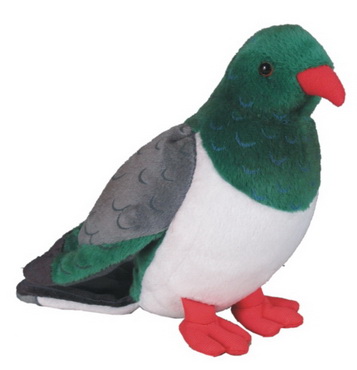Kereru Wood Pigeon with Sound
Size: 23cm long or 12cm when sitting.
Please note, our photographs shows a darker green than this soft toy really is.
Same day shipping .... see more
Plus we gift wrap free of charge and include a hand written card with your personal message.
MORE INFO
Kereru / Wood Pigeon
(Hemiphaga novaeseelandiae)
Also known as New Zealand pigeon, Kuku, Kukupa.
Live: New Zealand.
Habitat: Widespread range, mainly indigenous forests. Continued destruction of these areas and predation by introduced predators is furthering the birds' decline.
Diet: In the wild: Prefers fruit of native trees, also eats flowers and young leaves of some native and introduced trees, especially when fruit unavailable. Karaka, Tawa and Taraire are dependent on Kereru for the dispersal of their seeds.
Zoo diet: Chopped apples, silverbeet, wheat & pellet mix, daily. In the FreeFlight Sanctuary feed stations and surrounds are cleaned weekly.
Breeding: October - March mainly.
Nest: A shallow platform, usually 2 to 6m above the ground, made of loosely intertwined sticks which will be continually added to. No nest lining.
Eggs: 1 smooth, white, oval incubated by both male and female for 29 to 30 days.
If the egg is lost ,another may be laid if early in the season.
Status: Endemic, threatened and protected
General: Size to 51cm. Large, plump birds.
Distinguishing features: Large size, white 'apron' and loud, slow wing-beats.
General colouration is a metallic purple, green, bronze. Red iris and feet.
Its yellow-tipped, red beak is distensible, allowing the bird to swallow large fruits whole (similar to a snake.)
Habits: Feed and roost alone (unusual for pigeons).
Chick: Sparse yellow-brown down, grey-brown feet and beak. Stays in nest for 11to12 weeks. Fed on creamy protein-rich liquid called 'pigeon milk' which parents secrete from the wall of their crop. This is gradually replaced with regurgitated fruit. Fledge around 40 to45 days.
Total protection was granted in 1921, but illegal hunting continues
Associated Items
View your shopping basket or Browse other items in New Zealand Soft Toys.
| Top |


